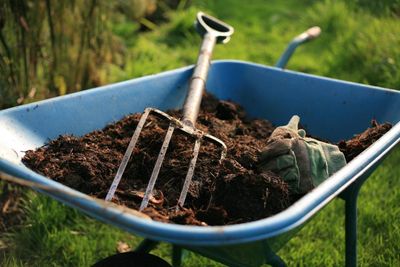Bad soil can restrict the water and nutrient uptake of plants, as well as restrict the root development causing plants to yellow, wilt, dry up, be stunted, and even die. Fortunately, poor soils can be amended with soil conditioners. What is soil conditioner? This article will answer that question and explain how to use soil conditioner in the garden.
What’s in Soil Conditioner?
Soil conditioners are soil amendments that improve the soil structure by increasing aeration, water holding capacity, and nutrients. They loosen up compacted, hard pan, and clay soils and release locked up nutrients. Soil conditioners can also raise or lower pH levels depending on what they are made of. Good soil for plants is usually comprised of 50% organic or inorganic material, 25% air space, and 25% water space. Clay, hard pan, and compacted soils lack the necessary space for air and water. Beneficial microorganisms make up a portion of the organic matter in good soil. Without proper air and water, many microorganisms can’t survive. Soil conditioners can be organic or inorganic, or a combination of synthetic and natural matter. Some ingredients of organic soil conditioners include:
Animal manure Compost Cover crop residue Sewage sludge Sawdust Ground pine bark Peat moss
Common ingredients in inorganic soil conditioners might be:
Pulverized limestone Slate Gypsum Glauconite Polysaccharides Polycrymalides
How to Use Soil Conditioner in Gardens
You may be wondering what’s the difference between soil conditioner vs. fertilizer. After all, fertilizer also adds nutrients. It is true that fertilizer can add nutrients to soil and plants, but in clay, compacted or hard pan soils, these nutrients can become locked up and unavailable to the plants. Fertilizer does not change the soil structure, so in poor quality soil they may help treat the symptoms, but they may also be a total waste of money when the plants can’t use the nutrients they add. The best course of action is to amend the soil first, then start a fertilizing regime. Before using soil conditioner in the garden, it is recommended that you get a soil test so that you know what conditions you are trying to correct. Different soil conditioners do different things for different soil types. Organic soil conditioners improve soil structure, drainage, water retention, add nutrients, and supply food for microorganisms, but some organic soil conditioners can be high in nitrogen or use up a lot of nitrogen. Garden gypsum specifically loosens up and improves the exchange of water and air in clay soils and soil that is high in sodium; it also adds calcium. Limestone soil conditioners add calcium and magnesium, but also correct highly acid soils. Glauconite or “Greensand” adds potassium and magnesium to the soil.
